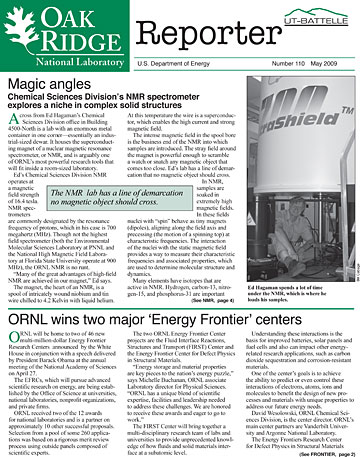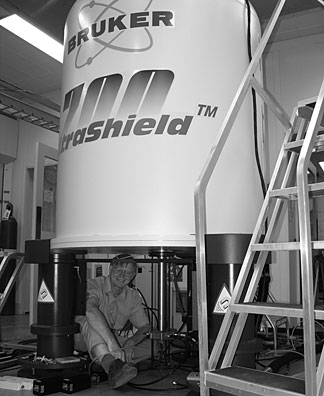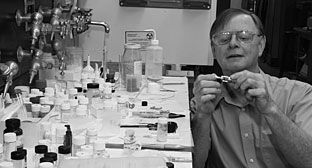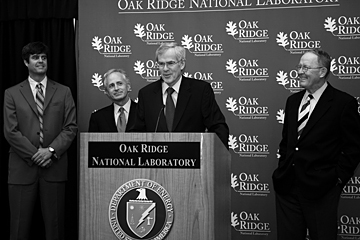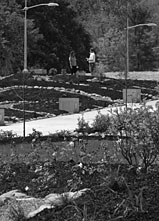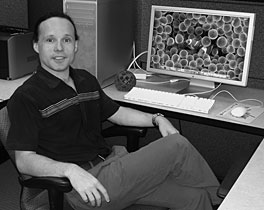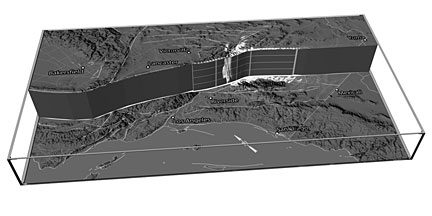 |
Number 110, May 2009 |
 Magic angles
Magic angles
Chemical Sciences Division’s NMR spectrometer explores a niche in complex solid structures
|
|
Ed Hagaman spends a lot of time under the NMR, which is where he loads his samples. |
Across from Ed Hagaman’s Chemical
Sciences Division office in Building 4500-North is a lab with an enormous metal container in one corner—essentially an industrial-sized dewar. It houses the superconducting magnet of a nuclear magnetic resonance spectrometer, or NMR, and is arguably one of ORNL’s most powerful research tools that will fit inside a room-sized laboratory.
Ed’s Chemical Sciences Division NMR operates at a magnetic field strength of 16.4 tesla. NMR spectrometers are commonly designated by the resonance frequency of protons, which in his case is 700 megahertz (MHz). Though not the highest field spectrometer (both the Environmental Molecular Sciences Laboratory at PNNL and the National High Magnetic Field Laboratory at Florida State University operate at 900 MHz), the ORNL NMR is no runt.
“Many of the great advantages of high-field NMR are achieved in our magnet,” Ed says.
The magnet, the heart of an NMR, is a spool of intricately wound niobium and tin wire chilled to 4.2 Kelvin with liquid helium. At this temperature the wire is a superconductor, which enables the high current and strong magnetic field.
The NMR lab has a line of demarcation no magnetic object should cross. |
The intense magnetic field in the spool bore is the business end of the NMR into which samples are introduced. The stray field around the magnet is powerful enough to scramble a watch or snatch any magnetic object that comes too close. Ed’s lab has a line of demarcation that no magnetic object should cross.
In NMR, samples are soaked in extremely high magnetic fields. In these fields nuclei with “spin” behave as tiny magnets (dipoles), aligning along the field axis and precessing (the motion of a spinning top) at characteristic frequencies. The interaction of the nuclei with the static magnetic field provides a way to measure their characteristic frequencies and associated properties, which are used to determine molecular structure and dynamics.
Many elements have isotopes that are active in NMR. Hydrogen, carbon-13, nitrogen-15, and phosphorus-31 are important isotopes in structural studies of organic compounds, Ed’s historical area of expertise. NMR parameters provide a wealth of information about small-molecule structures, such as amino acids, sugars and steroids, and large-molecule structures, as in proteins and plastics. The connection with structure is through subtle changes in the nuclear parameters due to the electron density at the nucleus. Electron density reflects bonding.
The implementation of pulse, Fourier transform (PFT) NMR dates from the mid ’60s with the advent of the Cooley-Tukey fast Fourier transform algorithm. Pulse NMR techniques sped up experiments by orders of magnitude and made the observation on NMR signals from dilute magnetic nuclei such as carbon-13 routine. Computer-intensive data analysis helps researchers deal with the copious and often redundant data produced by the technique.
“We can look at proton resonances in molecules at 700 megahertz and distinguish signals which differ by 0.01 hertz,” Ed says. “You need that level of resolution, one part in a billion, to determine protein structure. Large proteins have thousands of individual protons which, at high field, can be resolved. Each proton can report on its environment.”
“In the NMR method, you first assign unique resonances to protons in a particular amino acid residue and then establish the amino acid sequence in separate magnetization relay experiments,” he says. “The exciting part is that we have learned how to transfer magnetization both through bonds and through space in a coherent, trackable fashion.”
Hagaman is so enthusiastic about NMR that he periodically erupts into laughter while describing one “trick” or another. |
For example, if amino acid 21 in a protein-chain line shares a through-space interaction with amino acid number 78—in other words, they influence each other, like two proximate bar magnets—the protons of these two residues must be close in space in the folded protein structure.
“And you have gained an important constraint on how that protein is folded,” Ed says.
Three-dimensional structures with atomic resolution come from both NMR and X-ray methods. Of protein structures that are currently known, “about 15 percent are from NMR,” Ed says.
The two techniques have little in common and that fact makes them highly complimentary. X-ray crystallography requires a single crystal for measurements, and that often is a limiting step. Large molecules, like proteins, which have asymmetrically folded structures, often are very difficult to crystallize.
In contrast, the NMR measurements are made on the protein dissolved in water and undergoing translational and rotational reorientation motions. The protein can be in its folded, bound or denatured state. The long-term stability of proteins in solution can be a limiting factor in the NMR measurements, which take weeks or months.
|
Ed Hagaman examines a rotor assembly tool he uses for his NMR “magic angle spinning” technique. |
While most of the previously described research is performed in a liquid environment, Ed explores ways to use NMR on samples in the solid state. (In fact, after more than an hour of explaining NMR in liquids, Ed guffaws that “None of that is what I do.”)
He came to ORNL in 1976 proposing solid-state NMR as a tool to probe complex solid structures in exquisite detail.
“The main difficulty in solids is that magnetic interactions are static, giving broad lines and poor resolution, whereas the motion of materials in solution are both averaged and narrowed by reorientational motion,” he says.
Ed Hagaman is so enthusiastic about NMR that he periodically erupts into laughter while describing one “trick” or another, like “magic angle spinning,” to coax data out of his powerful setup. He grinds samples into powder and then spins them at extremely high speeds in the NMR at the “magic” angle, 54.73 degrees, the angle of mechanical rotation relative to the static magnetic field axis.
How fast? With the best technology, an astonishing 3.6 million rpm. The fast mechanical rotation narrows the broad lines typically found in the spectra of solids and gives beautiful resolution in the spectra and valuable chemical and structural information.
Gaining a spectroscopic signal is still difficult, particularly in that Ed is dealing with a very unfavorable signal-to-noise ratio. Ed’s goal is studying the solid-solid or solid-liquid interfaces in heterogeneous, amorphous systems. These may be metal oxide surfaces that hold catalytic particles or highly engineered, chemically modified mesoporous silicas, which serve as nanoreactors. It is at these interfaces, usually a small fraction of the sample, that he tries to gain structural and dynamic insight into the chemical reactions occuring in this venue.
“It’s a tough experiment because it’s so danged insensitive,” Ed says.
Ed has recently built extremely small NMR probes—μcoil detectors—that lower the atom threshold sensitivity. “We can now elicit a signal from as few as 1011 nuclei. The traditional number is 1018,” he says.
Misfortune introduced him to NMR technology: Ed came to ORNL from Indiana University, where he was studying organic chemistry. He became highly allergic to the alkaloids he was synthesizing.
“Organic chemistry was on the fifth floor of the building. I couldn’t get near the chemicals, so I worked on the sixth floor. That’s where the NMR spectrometers were,” Ed says.
Thus was his interest piqued. After a post-doctoral stint at Rice University he was hired at ORNL by the late physical organic chemist Clair Collins.
Recognizing the potential wealth of information that could be gained, Ed called for more work in solid-state NMR, which has resulted in improved techniques and his new and powerful instrument.
His current work focuses on solid state NMR of quadrupoles. Most of the elements in the periodic table fall into this category. Two years ago ORNL bought the new NMR and knocked a hole in his lab’s outside wall to move it into the building. The NMR will likely move again when the new Chemical & Materials Sciences Building is finished.
“Wherever the magnet is, that is where I’ll be developing new NMR tricks,” he says.
Pay a video visit to Ed Hagaman's NMR lab at http://ornlmedia.ornl.gov/WebWorks/ornltoday/hagamannmr.wmv.—B.C. ![]()
 ORNL wins two major ‘Energy Frontier’ centers
ORNL wins two major ‘Energy Frontier’ centers
ORNL will be home to two of 46 new multi-million-dollar Energy Frontier Research Centers announced by the White House in conjunction with a speech delivered by President Barack Obama at the annual meeting of the National Academy of Sciences on April 27.
The EFRCs, which will pursue advanced scientific research on energy, are being established by the Office of Science at universities, national laboratories, nonprofit organizations, and private firms.
ORNL received two of the 12 awards for national laboratories and is a partner on approximately 10 other successful proposals. Selection from a pool of some 260 applications was based on a rigorous merit review process using outside panels composed of scientific experts.
The two ORNL Energy Frontier Center projects are the Fluid Interface Reactions, Structures and Transport (FIRST) Center and the Energy Frontier Center for Defect Physics in Structural Materials.
“Energy storage and material properties are key pieces to the nation’s energy puzzle,” says Michelle Buchanan, ORNL associate Laboratory director for Physical Sciences. “ORNL has a unique blend of scientific expertise, facilities and leadership needed to address these challenges. We are honored to receive these awards and eager to go to work.”
The FIRST Center will bring together a multi-disciplinary research team of labs and universities to provide unprecedented knowledge of how fluids and solid materials interface at a subatomic level.
Understanding these interactions is the basis for improved batteries, solar panels and fuel cells and also can impact other energy-related research applications, such as carbon dioxide sequestration and corrosion-resistant materials.
One of the center’s goals is to achieve the ability to predict or even control these interactions of electrons, atoms, ions and molecules to benefit the design of new processes and materials with unique properties to address our future energy needs.
|
SENATE TRIO New Mexico Senator Jeff Bingaman (at the podium) visited ORNL for the first time on April 24. Joining the Energy and Natural Resources Committee chairman were (from left) ORNL Director Thom Mason and Tennessee Senators Bob Corker and Lamar Alexander. |
David Wesolowski, ORNL Chemical Sciences Division, is the center director. ORNL’s main center partners are Vanderbilt University and Argonne National Laboratory.
The Energy Frontiers Research Center for Defect Physics in Structural Materials will bring together researchers from ORNL, six universities, and Lawrence Livermore National Laboratory to address the most pressing basic research challenges in structural materials for energy.
The center’s goal is to provide atom-by-atom control and manipulation of defects that currently limit material performance and lifetime. Center scientists also will seek new ways to develop materials with unprecedented strength, toughness, radiation damage tolerance, and self-recovery.
The center will deploy first-of-a-kind measurements of defect dynamics and conduct fundamental calculations of the structure and dynamics of extended defects based on new and advanced approaches.
Malcolm Stocks, ORNL Materials Science and Technology Division, is the center director.
EFRC researchers will take advantage of new capabilities in nanotechnology, high-intensity light sources, neutron scattering sources, supercomputing and other advanced instrumentation—much of it developed with DOE Office of Science support over the past decade—in an effort to lay the scientific groundwork for fundamental advances in solar energy, biofuels, transportation, energy efficiency, electricity storage and transmission, clean coal and carbon capture and sequestration, and nuclear energy.
“As global energy demand grows over this century, there is an urgent need to reduce our dependence on fossil fuels and imported oil and curtail greenhouse gas emissions,” says Secretary of Energy Steven Chu. “Meeting this challenge will require significant scientific advances. These centers will mobilize the enormous talents and skills of our nation’s scientific workforce in pursuit of the breakthroughs that are essential to make alternative and renewable energy truly viable as large-scale replacements for fossil fuels.”—Mike Bradley ![]()
 West campus opens its ‘quad’
West campus opens its ‘quad’
ORNL staff members on the west campus celebrated their new “quad” on April 29 with a few remarks and a picnic. The new common area serves the primarily biological and environmental sciences-related facilities of the west end of ORNL with a landscaped pedestrian mall.
The new promenade has turned what before was essentially a parking lot into a gathering place for staff members and a showpiece entry way for the Joint Institute for Biological Sciences, which is also home to the BioEnergy Research Center.
“We want to attract the best and the brightest, and one way to do that is to have nice facilities and nice grounds. These kinds of things facilitate interactions among scientists and make it a pleasure to be on campus” says Biological and Environmental Sciences Directorate Operations Manager Barry
Berven.
|
The west campus plaza is now a showplace of native species plants. |
“People will be enjoying this for a lot of years to come,” Barry says.
The plants and trees are native species, keeping with a theme begun with the east campus quad in the early days of ORNL’s modernization. The plaza is dominated by a newly planted, 30-foot scarlet oak, joined by 81 smaller trees, 141 shrubs and 3,869 ornamental grasses and perennials.
“The oak will turn into a magnificent tree; very beautiful in the fall,” Barry says.
Other native species include sugar maple, black gum, iron wood and serviceberry trees; Virginia sweetspire, New Jersey tea, mountain laurel and parsoni juniper shrubs; and, in the grasses and perennials column, columbine, wild ginger, coneflower, beebalm, blue phlox and horsetail, a plant that invariably intrigues visitors to the east campus.
The project has a heavy Facilities & Operations Directorate representation, including Pat Parr, who helped select the native species, Mack Lakumb, Jeff Harrison and Cecil Peters. The landscape architect is Bob Hodgson of Flad Architects.—B.C. ![]()
 |
 RHIC-PHENIX experiment a classic
RHIC-PHENIX experiment a classic
A 2001 Physical Review Letters article detailing a “jet quenching” experiment at Brookhaven Lab’s Relativistic Heavy Ion Collider has gathered more than 500 citations since publication. The data from RHIC’s PHENIX detector system, which features a significant contribution from ORNL scientists and engineers, marked the first experimental evidence of a phenomenon called nuclear jet suppression, hence its quick accumulation of that milestone number of references.
The Physics Division’s Vince Cianciolo, one of a host of co-authors listed on the article, says the experiment confirmed what theorists suspected happened in heavy-nuclei collisions but had little evidence until the then newly started RHIC’s run.
“When two high-energy particles collide, sometimes the quarks and gluons hit each other head-on in a hard collision. Any time you knock out a quark or gluon, the particles cannot exist on their own and rapidly split into a cone of newly created particles called a jet, in a direction perpendicular to the beam direction. The momentum carried thusly is called transverse momentum, and is the key quantity to measure,” Vince explains.
The PHENIX detector researchers measured proton-proton collisions and then collided gold nuclei.
“Naively you would think the gold collision was like hitting a bunch of protons, which was the nothing-interesting-happened theory,” Vince says.
“But in gold a factor of five fewer particles are produced at high transverse momentum. This signals creation of some new type of nearly impenetrable matter.”
So, apparently something interesting happened.
Some theorists had predicted such effects, but the magnitude was much greater than expected. The explanation is that the gold collisions create a small but hot and very dense plasma that the jets must pass through. The interaction with the plasma “quenches” the particles to a lower energy.
Physics Division Director Glenn Young says theorists had a “field day” with the findings, generating a raft of publications citing the RHIC paper, whose publication was spearheaded by the Physics Division’s Paul Stankus.
“Theorists went to work on how the jets decay and when you’d see them. They keep adding pieces to the puzzle and citing this work,” Glenn says. “We saw very mature results from theory at the recent Quark-Matter 2009 meeting in Knoxville. It’s a classic example of how science works when discoveries are made.”
 Neutrons prove polymer theory
Neutrons prove polymer theory
Evidence gathered by researchers from ORNL and Princeton University has experimentally confirmed some long-held, yet previously unproven theoretical predictions concerning the behavior of polymers in “strong” solvents. Gang Cheng and Yuri Melnichenko, both of the Neutron Sciences Division, collaborated with William Graessley of Princeton to collect the elusive data using the state-of-the-art small-angle neutron scattering (SANS) instruments at the High Flux Isotope Reactor and at the National Institute of Standards and Technology.
The findings of the group, published in Physical Review Letters, were selected as an “Editor’s
Suggestion,” indicating high importance to the physics community.
A lack of experimental evidence demonstrating the effect of concentration on the structure of polymers in strong solvents has challenged the polymer science community for the past three decades. Previous experiments have used SANS but have given contradictory results because of limited capabilities of available SANS instrumentation.
The high neutron flux and resolution available at HFIR’s general-purpose SANS instrument enabled Gang and Yuri to collect enough data to resolve ambiguity in modeling the polymer’s behavior. Their findings revealed a distinct crossover in polymer structure from semidilute to concentrated solutions.
They explain that at lower concentrations, polymer chains swell in strong solvents because of repulsive interactions between the chain segments. However, at higher concentrations, “screening” of the repulsive interactions by other chains occurs, and once the polymer concentration passes a certain point, the solvent strength should no longer affect the chain size. These characteristics—long suspected but never observed—are very important for understanding the behavior of synthetic and biological polymers in various solvents, says Yuri.
HFIR’s general-purpose SANS is a first-rate tool for providing information about structures and interactions in soft, condensed matter like polymer solutions and complex fluids. The SANS instrument also has applications in hard condensed matter and magnetic systems such as superconductors, advanced ceramics and alloys.
Reported by Bill Cabage and Sarah Wright |
 Waiting for MaNDi
Waiting for MaNDi
Neutron scientist counts the days until he can use SNS’s intense beam
|
Leighton Coates will focus on aspartic enzymes when the SNS’s MaNDi instrument comes on line. |
Time flies when you’re having fun…with neutrons, especially. The tenth anniversary of the groundbreaking of the Spallation Neutron Source is approaching at the end of 2009, and it has already been three years since the first neutrons were produced at SNS. Ten instruments are currently receiving neutrons, with final plans including a total of approximately 25 neutron scattering instruments.
Despite the fact that fewer than half of the prospective instruments are operational, the SNS is a lively, bustling place. A lot of that bustle is due to the preparations that go into getting a neutron scattering instrument ready to receive neutrons.
One member of the group of instrument scientists working hard to get their instruments ready for experiments is Leighton Coates. His instrument, the Macromolecular Neutron Diffractometer, referred to as MaNDi, is projected to be ready in 2013.
So what is it like to be an instrument scientist working on an instrument whose first neutrons seem so far off? If you talk to Leighton, it’s pretty exciting stuff.
“I’m really hoping for an early finish date in 2012,” Leighton says, gesturing energetically in his chair.
His excitement is not so much about the instrument as it is about the science. He wants the instrument working because it will help him discover how enzymes work. Specifically, he wants to know how a particular class of enzymes work: aspartic proteinases, which cut proteins wherever they find a certain sequence of amino acids. Pepsin, the enzyme that helps us to digest our food once it reaches the stomach (or sometimes a little earlier if you’re an unlucky victim of heartburn), is one example of an aspartic protease.
Other examples aren’t so innocent: aspartic proteases are also involved in disease. For example, HIV’s infectivity depends completely on the action of its aspartic protease, without which the proteins made by the invading virus remain uncut and uninfectious. Because of this, HIV-1 protease is an area of intense study.
Traditional methods for studying enzymes include crystallization studies. The researcher purifies the protein in question and then tries to grow crystals. The procedure can be extremely challenging; if the protein isn’t pure enough, the crystals won’t form; if the environmental conditions aren’t just right, the crystals won’t form; sometimes if the protein is too pure, the crystals won’t form.
And the production of a crystal is just the beginning. The next step is analyzing the crystals using X-ray diffraction, or (this is where MaNDi comes back into the story) neutron diffraction. Neutron diffraction is very new research when it comes to proteins.
“Only 14 protein structures have been determined using neutrons at this point,” says Leighton, “but neutrons are very good for studying proteins.” He explains that about half of the atoms in a protein are hydrogen atoms. These hydrogen atoms are very important to scientists trying to figure out a protein’s structure or an enzyme’s active site. They are also nearly invisible using X-ray diffraction.
“If there is any movement at all, the hydrogen atoms tend to smear and become invisible,” says Leighton. However, using neutron crystallography in combination with a method that replaces the hydrogen atoms with deuterium, researchers can much better determine the locations of hydrogen atoms. Deuterium is a heavy isotope of hydrogen that is more visible to neutrons than regular hydrogen.
And while other neutron sources can accomplish similar research, the intense beam of neutrons at SNS means that studies can get done faster. Using the sources currently available, it takes about 30 days of beam time to conduct a thorough protein crystal diffraction study. Using MaNDi at SNS, Leighton estimates that it will take only about three days to perform a challenging neutron diffraction experiment.
When MaNDi comes on line, the high level goal is to collect 14 macromolecular structures in the first year, Leighton says. “This method can increase the numbers of protein studies that get completed, which greatly increases our knowledge of how enzymes work.”
Part of the reason that MaNDi will be faster than other neutron diffractometers is the intensity of the beam at SNS. There is also another set of advantages that MaNDi will have compared with other instruments: The sample will be surrounded by detectors.
The SNS’s intense beams will cut the beam time required for protein crystal diffraction experiments from 30 days to three. |
Leighton explains that when the neutrons bounce off of the sample, they go in all directions, and the more of those bouncing neutrons that you collect information about, the more information about the sample’s structure you capture.
Another advantage of combining the high intensity of the neutron beam at SNS with a large number of sensitive detectors is that it will improve the flexibility of the instrument. The high number of neutrons available makes it possible to study more than single protein crystals—other materials like fibers or advanced materials such as molecular magnets will also be studied using MaNDi.
Leighton explains, “Looking at cellulose fibers, for example, can be done with the higher divergence of the incident beam, which is possible with high neutron intensities speeding neutron scattering data collection. With MaNDi, we will be able to do these types of studies because we have a neutron source that produces a high-intensity beam line and the detectors to capture as much data as we can.”
Neutron scattering detectors are very expensive though, so MaNDi will only have about 30, Leighton says.
“I’d like to get more…because it’s the scattering of the beam that tells you the actual information. Increasing the number of neutrons collected reduces the time you need on the instrument,” he says.
Who knows, maybe between now and 2012 he can work some more detectors into the plan.—Sarah Wright ![]()
 Kraken simulates lotta shakin’ in southern California
Kraken simulates lotta shakin’ in southern California
|
SCEC’s physics-based programs simulate both the friction-based slip on the surface of a fault, called a dynamic rupture simulation, and the earthquake wave propagation through complex earth structure, called an anelastic wave propagation simulation. |
Very few things in life are certain. If you live in southern California, however, rest assured that some time in the next few decades you will experience an earthquake of significant magnitude.
And while the quake itself is probably unavoidable, knowing which areas will be most affected can do a great deal to mitigate its aftermath. For example, where will the strongest ground movement occur, and how long will the shaking last? Engineers crave this sort of data when they are designing the buildings of tomorrow.
Enter the Southern California Earthquake Center, an organization funded by the National Science Foundation and the U. S. Geological Survey in recognition of the seismic hazard that looms over Southern California like the heavy Los Angeles smog. In an effort to better understand when and where the next Big One will hit hardest, SCEC is taking advantage of the recently launched, NSF-funded supercomputer known as Kraken.
Located at the National Institute for Computational Sciences at ORNL and managed by the University of Tennessee, Kraken is the world’s fastest academic supercomputer with a peak performance of more than 607 teraflops, or 607 trillion calculations per second.
Simulations like those conducted on Kraken help SCEC create both scenario and probabilistic seismic-hazard maps. The former show the distribution of ground motions for a possible future earthquake; the latter reveal peak ground motions a site is likely to experience during a specified period in the future. Data gleaned from these maps is directly incorporated into building codes, prepping future structures for the next great quake and possibly saving lives and dollars when it hits.
Understanding ground motion and the physics of fault ruptures, or areas along a fault line that slip and thus cause seismic events, is crucial to determining the potential aftermath of an earthquake. Specifically, SCEC is modeling both these phenomena in a hypothetical 7.8-magnitude earthquake, noting where in southern California the ground is most sensitive to movement.
Most recently SCEC used Kraken to ensure that the organization’s software (known as AWP for Anelastic Wave Propagation) could run at the next level. And run it did. In fact, the simulations used more than 65,000 compute cores (out of 66,048 total), pushing the machine to its very limit and establishing a new record as far as sheer scale in seismological simulations. Now that the researchers are confident of AWP’s scalability, they can begin to take their science to the next level.
Simulations thus far have proved to be very accurate—so much so that if you compare the graph of a simulated quake (using data from an historical quake) with that of the observed data from the real earthquake, “they are nearly identical,” says SCEC’s Phil Maechling.
Unfortunately, this accuracy pertains to only lower frequencies, in this case 1 Hz and below. Lower frequencies affect only larger buildings, namely those 16 stories high or taller. Anyone who has ever seen a picture of Los Angeles knows that city is largely composed of shorter buildings, extending more outward than upward.
So to get a really good picture of how a 7.8 quake would shake up the shorter buildings that make up the majority of southern California, the team needs to simulate higher frequencies and thus rev up the resolution. Because of the geometry of the mesh used in the simulations, a twofold increase in resolution requires a 16-fold increase in computing power. Before computers such as Kraken, this was little more than wishful thinking.
With Kraken, however, refined resolution is not only possible, it’s forthcoming. Specifically, SCEC would like the next round of simulations to be in the neighborhood of 2 Hz, double the current resolution. Given the rate at which supercomputers are accelerating, it might not be that far off. In fact, a whole new era of seismic science may soon be possible. “We want to transform seismology into a more predictive science,” says Maechling, “like that of climate and weather.”—Scott Jones ![]()
|
 Club ORNL
Club ORNL
|
Several retired ORNL staff members recently attended the Women in Science and Engineering Celebration at ORNL. Left to right with the Nuclear S&T Division’s Peggy Emmett are Nancy Landers, Liane Russell, Carolyn Gooch, Fay Martin, Virginia Spivey Coleman, Mozelle Rankin Bell and Marty Adler-Jasny. |
Get the details and latest news on Club ORNL online via the ORNL home page and on ORNL Today. Retirees, to gain access to the ORNL home page, first register in XCAMS by going to http://www.ornl.gov/adm/ clubornl_signup.shtml. After receiving your XCAMS account and Club ORNL membership, retirees can then go directly to https://www.ornl.gov/ adm/clubornl. Ross Toedte, 574-1912, toedterj@ornl.gov, is the retiree point of contact.
|
 Editor’s note: Cryo pioneers
Editor’s note: Cryo pioneers
Peter Mazur, currently a research professor at the University of Tennessee’s Department of Biochemistry and Cell and Molecular Biology and formerly of ORNL’s Analytical Chemistry Division, noted upon reading the April Reporter (No. 109) article on the Mouse House that the “groundbreaking cryogenic technique” that enabled ORNL’s mouse colony to be transferred from the old Mouse House to the new facility in 2003, as mentioned in the article, was the subject of a cover article in Science magazine in October 1972 [Science, New Series, Vol. 178, No. 4059 (Oct. 27, 1972), pp. 411-414].
The cryo technique was developed by Mazur, fellow ORNL researcher Stanley Leibo and David Whittingham, a visiting scientist from the United Kingdom. ![]()
 New Staff Members
New Staff Members
Kenneth Ray Barker, Information Technology Services
James Maynard Eaton, Environmental Protection & Waste Svs (transfer)
Grace Lynette Jackson (re-hire), Nicholas Scott Pollino, Robert Darrell Lawhorn and Paul Scott Nogradi (re-hire), Facilities Management
Sirisha Nukala and David Estes Smith, Energy & Transportation Science
William Herbert Strong (re-hire), NScD Research Accelerator
Frank L. Combs, Measurement Science & Systems Engr
Scott Michael Koch and Ross Geoffrey Miller, Center for Computational Sciences
Kay Debusk Lenox, Velma Ann Williams,
Nina Patrice Wilson, Sonya Mowery, Sarah E. Nix, Angela Denise Brock and Lisa Ann Goins, Human Resources Dir.
Patrick Daniel Lynch, Global Nuclear Security Technology
Garvin Clay Morris, Bryan Woody, Jack Ramsey and Charles R. Nevius Jr., Nonreactor Nuclear Facilities
Edward Eugene Chatman, Jr. (re-hire) and Auzzie Bee Freeman Jr., Campus Support & Instrumentation
Millard Vance Sales, National Security Dir.
Dale Wesley Anderson, Global Initiatives Dir.
Laura Morris Edwards, Center for Nanophase Matl’s Sciences
Gabriel Marin, Computer Science and Mathematics
 Retiree news: CORRE seeks members’ e-mail
Retiree news: CORRE seeks members’ e-mail
The Coalition of Oak Ridge Retired Employees communicates with its retiree members and spouses in several ways: by continually updating the CORRE Website, making new information available to members who can access the Web (www.corre.info); through periodic e-mail messages; through notices in the newsletters of the contractor organizations; and even by “snail mail.”
E-mail is the preferred way to communicate because e-mail is prompt and inexpensive. However, the coalition has e-mail addresses for only 400 or so members, a small percentage of approximately 12,000 members.
As a CORRE member, you may add or change your e-mail address simply by sending an e-mail to Judy Kibbe, communications committee, at kandjkibbe@comcast.net.
“We will use it but never abuse it,” says Judy.
 ORNL People
ORNL People
High Temperature Materials Laboratory Director Edgar Lara-Curzio has been chosen for the 2009 Arthur Frederick Greaves-Walker Award from the American Ceramic Society and the National Institute of Ceramic Engineers, in recognition of his “outstanding service to the ceramic engineering profession.”
|
ELECTRIC RIDE Students from the Oak Ridge ARC brought an electric vehicle they designed to ORNL’s Earth Day celebration on April 16. The event featured ecology demonstrations, an alternative vehicle show and a swap of plastic grocery bags for reusable containers. |
The Materials S&T Division’s Louis K. Mansur will receive this year’s Mishima Award, given annually by the American Nuclear Society to recognize outstanding contributions in research and development work on nuclear fuels and materials. Lou is being honored for his international leadership in understanding fundamental mechanisms of radiation effects in materials.
ORNL bicycle commuter Dave Mullins of the Chemical Sciences Division was named March 2009 Commuter of the Month in the Knox TPO Smart Trips program. Dave consistently rides his bike on a 24-mile round trip to and from the Lab, weather and other duties permitting.
Energy & Transportation Science Division Director Johney Green participated in the National Academy of Engineering German-American Frontiers of Engineering program. Approximately 60 participants are invited, 30 engineers from each country.
Capt. John A. Groff of the Research Accelerator Division has received the Bronze Star for his “exceptional meritorious service.” John was the squadron motor officer for the 2nd Squadron, 278th Armored Cavalry Regiment from February 2005 to September 2005 during Operation Iraqi Freedom.
The Materials S&T Division’s Fue Xiong received the outstanding graduate award in mechanical engineering technology by the Engineering & Media Technology Department at Pellissippi State. ![]()
